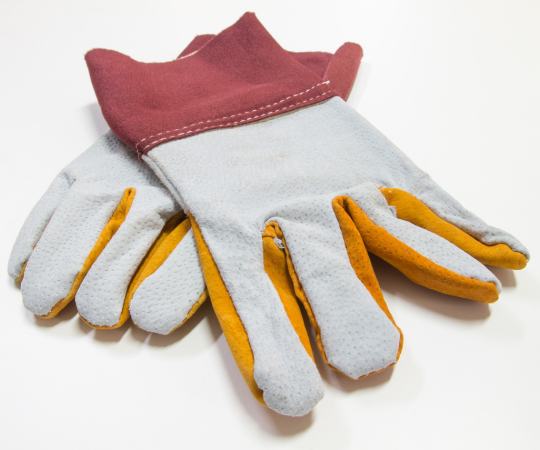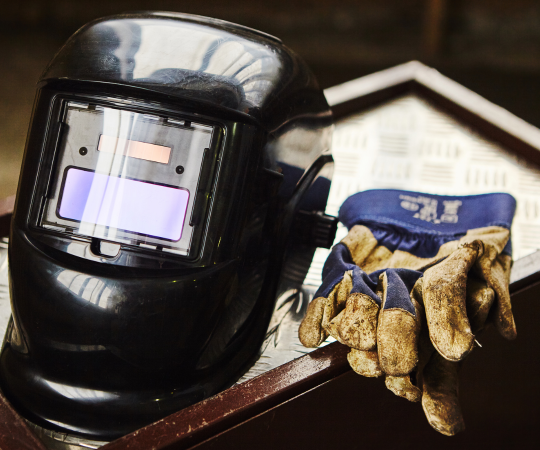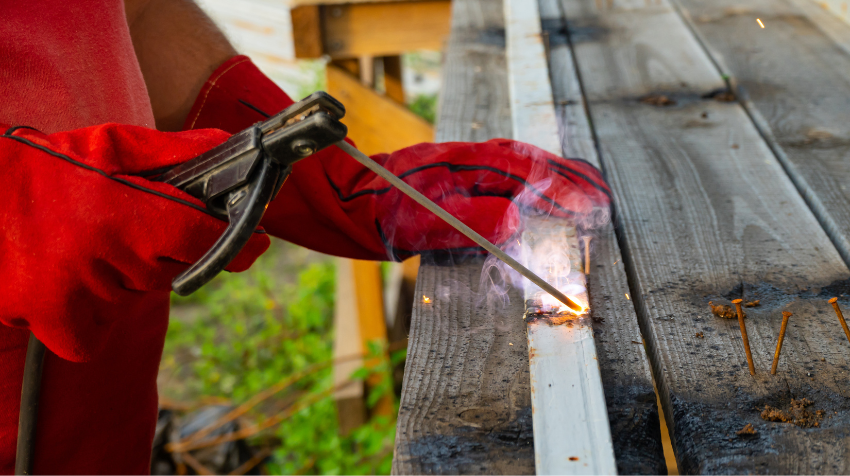Keeping Hands Safe in Style: A Comprehensive Welding Gloves Review
Are you a welder looking for the perfect pair of gloves that not only protects your hands but also looks good while wearing them? Look no further because we’ve got you covered!
In this comprehensive welding gloves review, we’ll go over the top options on the market so you can make an informed decision on what works best for you. Welding is a dangerous job that requires proper safety gear. One of the most important pieces is a pair of welding gloves. Not only do they protect your hands from burns and sparks, but they also provide added grip when handling hot materials.
But just because they’re functional doesn’t mean they have to be boring. With so many options available, it’s possible to find a pair that not only keeps you safe but also looks stylish in the process.
So let’s dive into our review and find the perfect welding gloves for you!
Importance of Welding Gloves
You can’t underestimate the importance of having proper hand protection while working with high temperatures and sparks. Safety precautions should be taken seriously in any workplace, but particularly when dealing with welding and metal fabrication.
Welding gloves are essential to protecting hands from burns, cuts, and other workplace injuries. Without proper hand protection, welders risk severe skin damage from arc rays or body parts getting caught in machinery.
The right pair of welding gloves can prevent these accidents from happening while also providing a comfortable fit that allows for optimal movement. When choosing welding gloves, there are several factors that you need to consider to ensure that the pair you select can provide adequate safety measures without compromising your comfort or dexterity.
Factors to Consider When Choosing Welding Gloves
When it comes to choosing the right gloves for welding, there are a few key factors you’ll want to keep in mind. First and foremost, pay attention to the design features of the gloves. Welding gloves should cover not just your hands but also part of your arms for maximum protection from heat and sparks. Look for gloves with reinforced stitching at high-stress points such as the fingertips and thumb.
Another important factor is material quality. Good quality welding gloves should be made of durable materials that can withstand high temperatures without melting or breaking down over time. Leather is a popular choice for its resistance to heat and flame, while Kevlar offers excellent cut resistance. Keep in mind that different materials may have different levels of comfort and flexibility, so it’s important to try on different options before making a final decision.
With these factors in mind, you can confidently choose a pair of welding gloves that will provide both safety and style on the job. Moving forward into our next section, let’s take a look at some top welding glove options on the market today.

Top Welding Gloves on the Market
If you’re in the market for a pair of reliable welding gloves, it’s worth checking out some of the top options available today. These gloves are made from durable materials like leather or Kevlar, and they offer a comfortable fit that won’t hinder your ability to work.
Some popular options include the Lincoln Electric Traditional MIG/Stick Welding Gloves, which are made from cowhide leather with a heat-resistant lining for added protection. Another option is the Revco Black Stallion BSX Extreme Welders Glove, which features a padded palm and reinforced thumb for improved grip and durability.
For those looking for something even more heavy-duty, there’s the Tillman 875 Heavyweight Top Grain Cowhide Welding Glove. These gloves have an extra layer of leather on the back of the hand and cuff for added protection against sparks and heat.
No matter what type of welding project you have in mind, there’s sure to be a pair of gloves that will meet your needs. In the next section, we’ll take a closer look at the pros and cons of each type of welding glove so you can make an informed decision about which one is right for you.
Pros and Cons of Each Type of Welding Gloves
Now, you might be thinking that investing in a pair of high-quality welding gloves isn’t worth the extra expense, but consider how much protection they offer against the dangers of welding and how much peace of mind that can bring.
When it comes to choosing the right welding gloves for your needs, it’s important to weigh the pros and cons of each type of glove material as well as price versus quality.
Here are some things to consider when comparing welding glove materials:
- Leather: Durable and heat-resistant, but can be stiff and lack flexibility.
- Synthetic: More flexible than leather with good heat resistance, but not as durable.
- Kevlar: Offers excellent cut resistance and heat protection, but is less flexible than other materials.
- Cotton: Lightweight and breathable, but offers little protection against sparks or flames.
- Aluminized: Reflects radiant heat well, but can be heavy and restrictive.
When considering price versus quality for welding gloves, keep in mind that cheaper gloves may save you money up front but could wear out quickly or fail to provide adequate protection. On the other hand, expensive gloves may offer excellent durability and protection but could be overkill for your specific needs.
Finding the best value welding gloves requires balancing these factors based on your own personal preferences and budget. As with any safety gear investment though, it’s always better to be safe than sorry, so don’t compromise on quality.
Moving forward into our conclusion and recommendations section…
Conclusion and Recommendations
When it comes to choosing the best welding gloves, it’s important to consider your individual needs and preferences. After reviewing the pros and cons of each type of welding glove, you may have a better understanding of which type is right for you.
Whether you’re a professional welder or a DIY enthusiast, we recommend investing in high-quality gloves that prioritize both safety and comfort.
Summarize the Best Welding Gloves
Looking for the top picks in welding hand protection? Check out our rundown of the best options on the market. We’ve done a thorough welding gloves comparison to bring you the top-rated welding gloves that provide both safety and style.
Here are our four favorite picks:
- Lincoln Electric Traditional MIG/Stick Welding Gloves – made with high-quality leather and Kevlar stitching, these gloves offer excellent heat resistance.
- Miller Electric TIG Welding Gloves – perfect for TIG welding, these lightweight gloves provide excellent dexterity while still protecting your hands from heat.
- Tillman 875 Stick Welding Gloves – made with premium shoulder split cowhide, these durable gloves provide great protection while also being comfortable to wear.
- Revco GM1611 Top Grain Leather Cowhide MIG Welding Gloves – designed specifically for MIG welding, these gloves feature a padded palm and reinforced thumb for extra protection.
Now that you know which welding gloves are worth investing in, let’s move on to offering recommendations for different types of welding needs.
Offer Recommendations for Different Welding Needs
You don’t want to be caught with the wrong pair of gloves during your next welding project, so let’s explore which gloves are best suited for your specific needs.
For MIG and TIG welding, consider gloves made from goatskin or cowhide leather for their flexibility and dexterity. If you’re working with heavier materials, such as steel beams, opt for gloves made from split cowhide or pigskin as they offer more protection against sparks and heat.
When it comes to budget considerations, synthetic materials like Kevlar and Nomex can provide excellent protection at a lower cost than leather options. However, keep in mind that synthetic materials may not be as durable as leather over time.
Ultimately, it’s important to find a balance between price and quality when selecting welding gloves based on your specific needs. By considering both the material type and budget constraints before making a purchase, you’ll be well-equipped to stay safe and stylish during your next welding project.

Frequently Asked Questions
How often should welding gloves be replaced?
Like all good things, welding gloves have a shelf life. They’re not invincible and will eventually wear out after prolonged use. The durability of your gloves is influenced by multiple factors such as the quality of material they’re made from, the frequency of use, and the extent to which they’re exposed to heat and other hazardous materials.
That being said, it’s important to keep an eye on their condition and replace them when necessary. As a general rule of thumb, you should replace your welding gloves every 6-12 months depending on how often you use them. If you notice any signs of damage or wear and tear such as holes or fraying in the seams or fingertips, then it’s time for a new pair!
Remember that investing in high-quality gloves is essential for both safety and comfort while working with hot metal objects.
Are there any specific materials or features to look for in welding gloves for high heat applications?
When looking for welding gloves that can withstand high heat applications, there are specific materials and features to consider. High heat resistance is crucial and can be achieved through the use of materials such as leather, Kevlar, or aluminized fabrics.
Look for gloves with reinforced seams and cuffs for added protection against heat and sparks. Comfort and flexibility are also important factors to balance safety with comfort. Consider gloves with a pre-curved design to reduce hand fatigue and allow for better dexterity.
Some gloves also feature sweat-wicking properties to keep your hands dry during long periods of use. By prioritizing high heat resistance while also considering comfort and flexibility, you can find welding gloves that will keep you safe without sacrificing comfort.
Can welding gloves be used for other tasks besides welding?
Multi-purpose gloves are becoming increasingly popular as people seek out versatile items that can serve multiple purposes. In fact, a recent survey found that over 60% of people who purchase welding gloves also use them for other tasks besides welding.
While welding gloves are designed to withstand high heat and provide protection against flames and sparks, they can be used for a variety of activities such as gardening, woodworking, and even cooking. However, if you’re looking for alternatives to welding gloves specifically for these tasks, there are options available such as oven mitts or gardening gloves that may better suit your needs.
Regardless of what you choose, it’s important to look for durable materials and features that will keep your hands safe while performing any task.
Are there any special care instructions for maintaining welding gloves?
When it comes to maintaining your welding gloves, there are a few cleaning tips that can help extend their durability. First, always check the manufacturer’s instructions for any specific care guidelines.
Generally, you should avoid using harsh chemicals or abrasive materials when cleaning your gloves. Instead, use a mild soap and lukewarm water to gently scrub away any dirt or grime. After washing, make sure to thoroughly rinse and air dry your gloves before storing them in a cool, dry place.
Additionally, regular inspections of the stitching and overall condition of your gloves can help ensure they remain in good working order for as long as possible.
How do I know if my welding gloves fit properly?
You may not realize it, but the proper fit of your welding gloves is essential to your safety and comfort while working. Gloves that are too loose can slip off and expose your skin to hot metal or sparks, while gloves that are too tight can restrict movement and cause discomfort.
It’s important to take the time to measure your hands properly and choose gloves in the correct size. Don’t just assume that one size fits all – different brands and styles may have slightly different sizing guidelines.
By taking the time to ensure a proper fit, you’ll be able to work more efficiently and with greater confidence, knowing that your hands are protected from harm.
Conclusion
Congratulations! You’ve now come to the end of our comprehensive welding gloves review. By now, you should have a good understanding of the importance of welding gloves, what factors to consider when choosing them, and the top welding gloves on the market.
To recap, we’ve discussed that welding gloves are essential for protecting your hands from burns and other hazards while also providing grip and dexterity. When choosing welding gloves, it’s important to consider factors such as material, thickness, length, and comfort. We’ve also reviewed some of the best options available in terms of leather and synthetic materials.
In conclusion, remember that safety comes first when it comes to welding. Choosing the right pair of gloves can make all the difference in preventing injuries and ensuring a successful project.
So don’t skimp on quality or take shortcuts – invest in a reliable pair of gloves that will keep you safe and stylish at work! As they say, ‘better safe than sorry.’
Related Source

